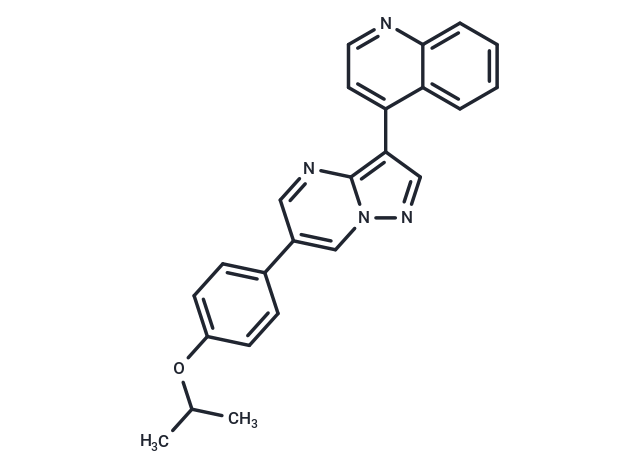Shopping Cart
- Remove All
 Your shopping cart is currently empty
Your shopping cart is currently empty

DMH-1 is a potent and selective Bone Morphogenetic Protein (BMP) inhibitor.

| Pack Size | Price | Availability | Quantity |
|---|---|---|---|
| 5 mg | $53 | In Stock | |
| 10 mg | $84 | In Stock | |
| 25 mg | $163 | In Stock | |
| 50 mg | $291 | In Stock | |
| 100 mg | $455 | In Stock | |
| 500 mg | $987 | In Stock | |
| 1 mL x 10 mM (in DMSO) | $63 | In Stock |
| Description | DMH-1 is a potent and selective Bone Morphogenetic Protein (BMP) inhibitor. |
| Targets&IC50 | ALK2:107.9 nM |
| In vitro | METHODS: HEK293 cells were treated with DMH-1 (1-20 µM) for 30 min, then incubated with BMP4 (50 ng/mL) or Activin A (40 ng/mL) for 30 min, and the expression levels of target proteins were detected by Western Blot. RESULTS: DMH-1 blocked BMP4-induced Smad 1/5/8 phosphorylation in HEK293 cells. In contrast, DMH-1 had no effect on BMP4-induced p38 MAPK phosphorylation and Activin A-induced Smad2 phosphorylation in HEK293 cells. [1] METHODS: hiPSC cells were treated with SB43154230 with Noggin (500 ng/mL) or DMH-1 (0.5 µM) for 7 days and the expression of neural precursor markers was detected by qRT-PCR. RESULTS: Neuralization of DMH-1 and Noggin produced a significant percentage of PAX6-positive cells on day 7 in six of the eight cell lines examined. In two cell lines, SM5 and TSC-12B4, the number of PAX6-positive cells was higher in cultures neuralized with Noggin. [2] |
| In vivo | METHODS: To detect anti-tumor activity in vivo, DMH-1 (5 mg/kg, 12.5% 2-hydroxypropyl-β-cyclodextrin) was injected intraperitoneally every two days for four weeks into SCID mice bearing A549 xenografts. RESULTS: DMH-1 treatment significantly reduced tumor growth in the human tumor xenograft model. At the end of the 4-week treatment, DMH-1 treatment resulted in a significant reduction in tumor volume of approximately 50% compared to the vector control. [3] |
| Kinase Assay | Kinase assay: All kinase assays are conducted by Reaction Biology Corp. In brief, compounds are tested at 10 concentrations by 3-fold serial dilutions starting at 30 μM, using nonspecific kinase inhibitor staurosporine as control. In vitro kinase reactions are carried out in the presence of 10 μM (33P)γATP. Five kinases tested are the human BMP type-I receptor activin receptor-like kinase 2 (ALK-2/ACVR1), the human TGFβ type-I receptor activin receptor-like kinase 5 (Alk5/TGFβR1), the human VEGF type-II receptor (KDR/Flk-1/VEGFR2), the human AMP-activated protein kinase (AMPK/A1/B1/G1) and the human platelet-derived growth factor receptor-β (PDGFRβ). |
| Cell Research | About 10,000 A549 cells per well are seeded in 96-well plates and incubated for overnight. The culture medium is then changed to fresh medium containing DMSO or DMH1 at various concentrations. The cells are then incubated for 48 hours and 96 hours before treatment termination by replacing the medium with 100 μL of 10% trichloroacetic acid in 1× PBS, followed by incubation at 4°C for at least 1 hour. Subsequently, the plates are washed with water and air dried. The plates are stained with 50 μL 0.4% sulphorhodamine assay in 1% acetic acid for 30 minutes at room temperature. Unbound dye is washed off with 1% acetic acid. After air drying and solubilization of the protein-bound dye in 10 mM Tris solution, absorbance is read in a microplate reader at 565 nm.(Only for Reference) |
| Alias | DMH1 |
| Molecular Weight | 380.44 |
| Formula | C24H20N4O |
| Cas No. | 1206711-16-1 |
| Smiles | CC(C)Oc1ccc(cc1)-c1cnc2c(cnn2c1)-c1ccnc2ccccc12 |
| Relative Density. | 1.24 g/cm3 (Predicted) |
| Storage | Powder: -20°C for 3 years | In solvent: -80°C for 1 year | Shipping with blue ice. | ||||||||||||||||||||
| Solubility Information | DMSO: 12.5 mg/mL (32.86 mM), Sonication is recommended. Ethanol: < 1 mg/mL (insoluble or slightly soluble) H2O: < 1 mg/mL (insoluble or slightly soluble) 10% DMSO+40% PEG300+5% Tween 80+45% Saline: 1.25 mg/mL (3.29 mM), suspension.In vivo: Please add the solvents sequentially, clarifying the solution as much as possible before adding the next one. Dissolve by heating and/or sonication if necessary. Working solution is recommended to be prepared and used immediately. | ||||||||||||||||||||
Solution Preparation Table | |||||||||||||||||||||
DMSO
| |||||||||||||||||||||

Copyright © 2015-2025 TargetMol Chemicals Inc. All Rights Reserved.